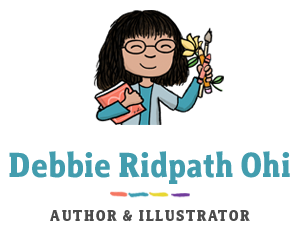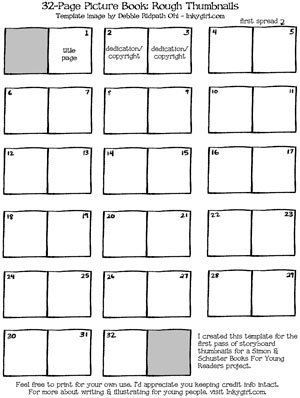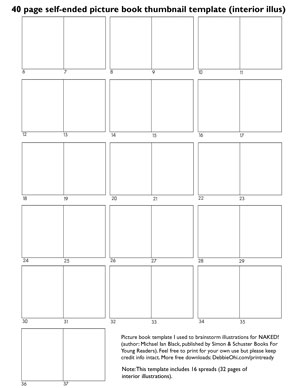
When I was asked to illustrate my first picture book (I’m Bored) and I started researching picture book formats, I was confused. I knew a standard picture book had 32 pages, for example, but I discovered that these 32 pages might also include the title page and other non-story pages. Plus some books had the story beginning on the right-hand page while others started on the left.
WHERE SHOULD I BEGIN? My editor and art director helped guide me and even though I still get confused about terms like “self-ended” and “paste-down,” I’m gradually learning. For expert explanations, see the resources I’ve listed at the end of this post.
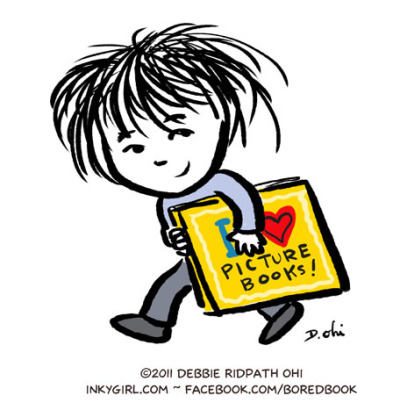
How Many Pages? Here’s What I’ve Learned So Far…
The number of pages varies in a picture book; it depends on the publisher as well as the project. If you’re submitting a picture book dummy or paged out picture book mss, however, I’d suggest starting with the standard 32 pages. If you really need the extra room, go for 40…but keep in mind that the more pages a book has, the more expensive it will be to print. The reason that the number of pages in picture books tend to be in increments of 8 is because of the way they’re printed; see resources at the end of this post for more info.
See below for the informal templates I’ve created for myself; I’m providing them here in case some of you find them useful in your own brainstorming process. The first two are templates I’ve used to brainstorm story layout for picture books. The squares are tiny on purpose, so I can squeeze the entire layout onto one page to make it easier for me to see overall visual flow. These early sketches are usually stick figures and only the essence of emotions and gestures; I don’t bother with details.
Feel free to download/print any of the following for personal use:
I created the last few brainstorming templates for when I’m coming up ideas on how to illustrate a particular spread. For example, suppose the first page text was “The squirrel was surprised.” and the second page had “He ran away.” My sketch ideas could be something like this:
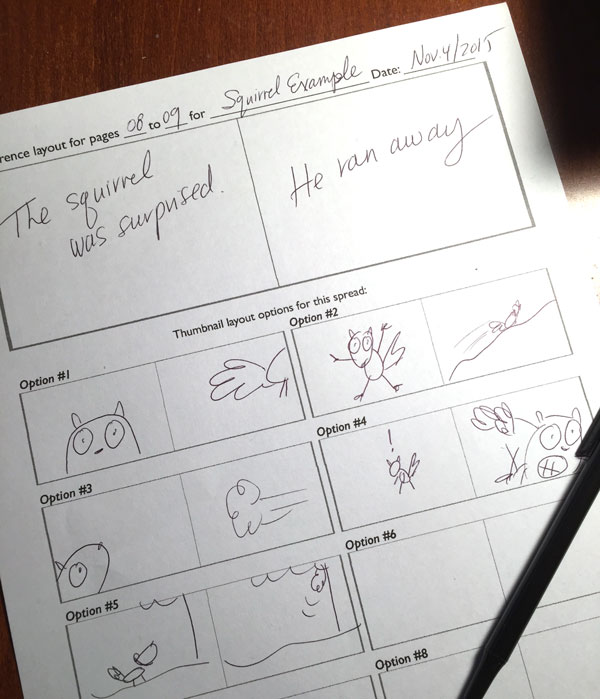
For illustrations that are a full spread, I draw across the gutter line. If there are two or more spot illustrations on a page, I draw very very tiny (I use a Pigma Micron 01). If there is a lot more text than I can or want to write out in the top bit, I just write a few words or phrase to remind me.
For the final choice, I’ll sometimes mix and match — I may like the first sketch I did in Option #3 but prefer the second sketch from Option #4, so I’ll combine them.
Anyway, this template helps encourage me to explore different ways of illustrating a spread and NOT to just go for the first thing that comes to my mind. When I’ve made my choice, I’ll take the thumbnail sketch idea and work it into a bigger sketch; I usually scan the page and then crop out the particular thumbnail that I want — that way I can preserve the original energy/feel.
This brainstorming phase is the only time I work low-res. After this, I usually switch to high-res (full dimensions), even for early sketches, just in case I really like (or my art director or editor) really likes some aspect of the early sketch.
For more free print-ready material, see Debbie’s Print-Ready Archives.
Other places where you can find more picture book layout templates and useful info:
If you know of other useful resources, please post them in the comments below, thanks!
An Illustrator’s Guide To Creating A Picture Book – by Meghan McCarthy. No templates, but a good overview for those who are just starting out.
Picture Book Dummy, Picture Book Construction: Know Your Layout by Tara Lazar. Explanation of self-ended and colored ends picture book layouts.
Basic Book Construction by Editorial Anonymous. Includes info about why most picture books have 32 pages.
Picture book layout templates by Scott Franson. 32 page + endpaper in portrait, landscape and square formats.
Harold Underdown’s The Purple Crayon: includes a TON of info about children’s book publishing, especially the basics for those just starting out.
Picture Book Standards: 32 Pages – by Darcy Pattison

